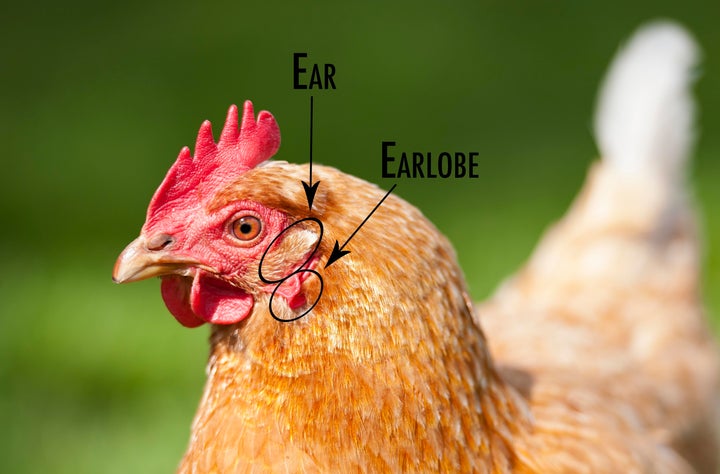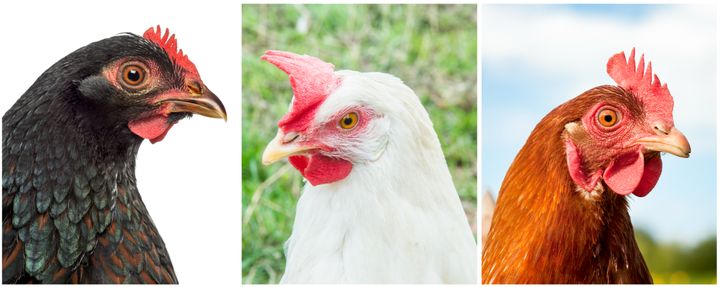It has a lot to do with a super-specific chicken body part. And no, they’re not healthier than white eggs.
If you ever find yourself in a confused stupor at your grocery store egg case, first of all, snap out of it. But you’re not alone, because there are a million confusing labels on egg cartons these days, and many of them mean nothing.
Despite that, there’s one constant: brown eggs are almost always more expensive than white eggs. Surely, this means they’re organic, more nutritious, superiorly delicious and blessed by golden angels, right?
Not necessarily. Everything you thought you knew about white eggs and brown eggs is about to get scrambled.
We talked to egg experts who addressed a number of canards about brown and white eggs, including the theory that eggshell color is based on the color of a chicken’s feathers (turns out that’s not entirely true), the nutritional difference between brown and white eggs, and how a chicken’s earlobes can determine the price of your eggs. Seriously.
There’s a lot more to the incredible egg than you may have realized. Let’s get cracking, and address some of the folk wisdom.
True or false? White-feathered hens lay white eggs, and brown-feathered hens lay brown eggs.
NPR ruffled listeners’ feathers with a 2006 “All Things Considered” report suggesting that all white-feathered chickens lay white eggs, and all brown-feathered chickens lay brown eggs. Poultry-loving listeners lost their minds and bombarded the show with complaints of fowl play.
Deana Jones, a research food technologist at the U.S. Department of Agriculture, backs up those listeners. Though the feather theory can be true, it has its flaws.
“Feather color does not necessarily denote eggshell color, because we have some white-feathered chickens that lay white-shell eggs, but we also have some that absolutely look like they walked through a bottle of bleach that lay brown-shell eggs,” Jones explained to HuffPost.
Jacquie Jacob, from University of Kentucky’s department of animal and food sciences, pointed out a big exception to the theory. “[Some] breeds have different varieties with different feather colors, but they all lay the same color egg,” she told HuffPost. Leghorns, for example, can have white, brown or black feathers, “but they all lay white-shelled eggs.”
There are entire charts dedicated to explaining which breeds of hens produce which color eggs. Though many commercial hens have been bred so that white-feathered hens lay white eggs and brown-feathered hens lay brown eggs, there are a number of “boutique chicken” varieties, such as Araucana chickens, which lay eggs that range in color from green to blue. And of course, their feathers aren’t green or blue.
So if a hen’s feathers don’t indicate a bird’s egg color, what does?
Chickens have earlobes, and they can predict the future.
“The hen’s earlobes give us a more accurate assessment of the color egg they’ll lay,” said Jones.
Though earlobes aren’t a perfect indicator of shell color, they’re more accurate than feathers.
“There’s always an asterisk in nature, but red earlobes generally denote brown-shell eggs, and white earlobes generally denote white-shell eggs,” Jones said.
And yes, chickens do have earlobes.

“They have to hear,” Jones explained. “A chicken earlobe looks different from ours ― it’s not a human ear stuck on the side of a chicken ― but it still serves a purpose. Chickens are a tasty treat for some predators, so they need to be able to hear.”
Backyard chicken enthusiasts disagree on whether a chicken’s earlobe is an accurate indicator of egg color. There’s even a forum on the BackYard Chickens website called “Please Everyone – Earlobe Color Has Nothing To Do With Egg Color.”
Experts beg to differ.
“The color of the shell is breed dependent,” Jacob said. “It is somewhat related to earlobe color, genetically speaking, in that most breeds with red earlobes lay brown-shelled eggs, and most with white earlobes lay white-shelled eggs.”
And, in defense of the “All Things Considered” segment that upset so many, there is a close correlation between earlobe color and feather color, especially in commercial chickens.

Once you understand how brown eggs get their color, you’ll know why they’re more expensive.
Though you’ve likely never given much thought to the inner workings of a hen’s reproductive system, it’s oddly fascinating. And so is the way a shell gets its color.
The short answer: The brown color on an egg is deposited on the shell in the hen’s “shell gland pouch,” also known as the uterus. The shell gland pouch is often referred to as the “paint station,” because that’s where pigment is deposited on the shell.
The long answer is way more interesting: According to Michigan State University Extension, a single egg is formed in about 26 hours, start to finish, and a hen can produce about one egg a day during her prime (usually the first two years of her life).
The egg’s journey begins as a yolk in the hen’s ovary. Once ovulation occurs, the yolk enters the oviduct tube, where it spends about three hours developing an egg white (albumen) to surround the yolk, and then it spends about 75 minutes developing its shell membranes. Next, the egg moves to the shell gland, where the shell is formed.
“That’s where the egg spends the longest amount of time,” Jones explained. “It puts down layer upon layer of shell as the egg sits in the shell gland, and it’s in there for at least 20 hours on average to form the shell. At the very end of the shell-making process, the pigment gets added, almost like you’re painting a house.”
All eggs start out white, and eggs that end up white simply skip their stop at the paint station.
“A white egg goes through the exact same process,” said Jones, but “there’s no pigment added at the end because [a white shell-laying hen] is just not genetically programmed to do that.”
Here’s the key to what makes brown eggs more expensive than white: “The brown egg layers need to have more nutrients and energy in their body to produce an egg than the white shell layers,” Jones explained. “It takes more feed for a brown-shell egg layer to accommodate production of the egg.”
White eggs rule in the U.S. Here’s why.
Marc Dresner, manager of marketing and communications for the American Egg Board, which represents egg producers, said white eggs are immensely more popular in the United States than brown eggs.
Dresner provided HuffPost with Nielsen data from December 2017, which he said is a “pretty good proxy for the year in general.” Those numbers show that brown eggs only account for only 9.4 percent of the fresh egg volume sold in the U.S. commercially.
The primary reason white eggs are more popular is because of their lower price. Not only do consumers prefer a more affordable product, but commercial food companies will almost always choose the cheaper option.
“You don’t see a lot of brown eggs being used directly in products,” Dresner explained. “Food formulators that are using liquid eggs or frozen product or powdered egg product probably are using white commodity eggs for that.”

Different regions feel differently about brown vs. white eggs. Just ask New England.
“There’s a regional preference for shell color,” Jones explained. “People have all kinds of hangups about food, and the egg industry is very cognizant of it and they ensure that whatever the needs are in that region, it’s what you’re seeing in your egg case.”
The proof is in the numbers. Nielsen tracks U.S. egg sales in nine regions. All heavily favor white-shelled eggs, except one: New England (Maine, Vermont, New Hampshire, Rhode Island, Connecticut and Massachusetts).
In New England, 51.1 percent of the eggs sold in December 2017 were brown eggs.
The region with the next-highest ratio of brown-to-white egg sales was the Middle Atlantic (New York, Pennsylvania, New Jersey), where 11.2 percent of the eggs sold were brown. The percentage declines in other regions.
What makes brown eggs so popular among New Englanders?
“It could be in part because they may have more red hens in New England,” Dresner guessed. “So it could simply be that locally those eggs are more accessible.”
Let’s make this clear: There’s no nutritional difference between brown eggs and white eggs.
So, if brown eggs are laid by hens that require more feed, that would make the eggs more nutritious, right? Wrong again.
There’s no nutritional difference between comparable white eggs and brown eggs. If they’re both organic, or cage-free, or whatever other label you want to slap on an egg, a brown and white egg will have no significant nutritional difference.
As explained above, an egg’s content and shell are formed at opposite ends of the reproductive tract. The only difference in the reproduction process occurs at the very end, when the color is deposited. That’s after the egg’s nutritional content has been formed.
“I think there is a widespread misperception that somehow brown eggs are healthier or higher in certain nutritional properties than white eggs, and I think in part that’s probably driven by the fact that they’re a little more expensive,” Dresner explained. “A lot of people are under the misimpression that if an egg is brown, it’s organic, which is also not the case.”
In the end, does it matter what color eggs we buy?
If your priority is saving money, the answer to this question is yes. If nutrition is your primary concern, the answer is no. But what does the American Egg Board think? Will we be seeing a big push to promote brown eggs?
“We are agnostic in that respect,” said Dresner, the group’s spokesman. “Our mandate and our mission is to promote and inform the consumer about eggs. We like all the eggs, whether they’re organic, free-range, conventional commodity caged white eggs ― it doesn’t really matter to us. We love them all equally.”
Sounds like they’re not hatching a plan for change.
Credit: Source link